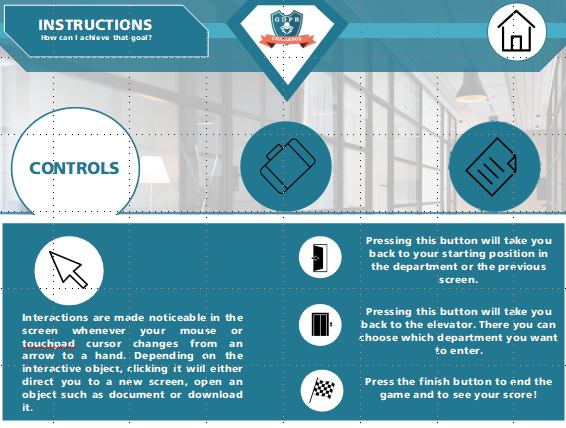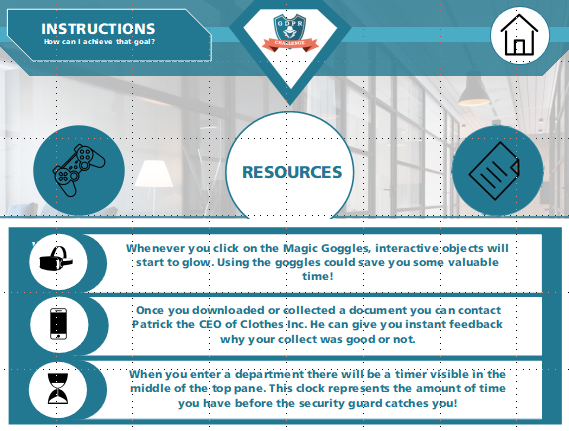Gamification: How to? Part 3: Autonomy
Giving Autonomy: implementing freedom in storyboard and Game play:
Most of the traditional e-learning modules are linear, not only in the progress from start to finish but also in problem solving.
In this game, we really wanted to surpass this by handing players the possibility of solving various problems in different sequences and discover ‘locked’ problems in their quest for the perfect game. You as the white hat hacker are able to unlock problems in one department after puzzling out a set of obstacles in another department. It means that you should be free to move from one department to the other while your collects (points) are saved.
However, the timer, representing the patrolling security, should still continue where it left off upon re-entering a department. This results in a game play that is characterized by fast decision making and excitement to complete the challenge in time. After conceptualizing the game objective, the narrative and a general idea of the game play, we draw up the Storyboard.
Another freedom I wanted to implement in the game play, is that the gamer is the agent of one’s own progress.
You should be able to skip screens and explore as much as possible, even though this could mean you don’t exactly know what to do.
Instructions, repeating information, simple navigation back-forth and objectives can help with this. If you choose not to read the instructions, trial and error is still an option. Providing resources or tools to the players in the game can avoid feelings such as frustration and boredom. Besides, it certainly helps you as an instructional designer to not constantly need to text-box instructions for each action.
And did I already mention how powerful the game mechanic “storytelling” is? In the challenge, players are given three resources by the CEO of our fictional company: A smartphone, goggles and a timer. In the narrative, the CEO explains that he informed the police about the coming break in. He also explains that he can track the security guard’s movements in the departments. He passes on that information in the countdown clock of the departments. Clicking on the ‘Magic Goggles’ resource highlights those objects that call for interaction.
After a player collects or downloads a document of which he thinks it contains privacy sensitive content, the smartphone resource is available in the top pane. If the player clicks, he reaches out to Patrick the CEO who is willing to give you individual feedback on why your collect was valuable or not.
Storytelling is not only a way to establish a certain relatedness to your training’s content. Moreover, it’s a mechanic that you can use to cover some of your design choices and make them acceptable. In this case, it is crucial, as it determines the core gameplay and helps me to give the player a well-considered challenge in which he is free to decide, explore, learn and even fail.
Conclusion
We showcased this gamified learning solution at an L&D fair late 2017. Without any instructions, attendees were free to give it a go. All types of professionals had an attempt and in general the GDPR challenge received a lot of praise.
- Visually they found the game attractive and the lip synced avatar animations that were included gave it a more dynamic feel.
- The content was relevant and they liked that the depicted departments and GDPR cases could easily be swapped with visuals from their own business.
- Fun and competition quickly took place when some people from the same organisation came to play in order to have a higher score than their direct colleague.
- Attendees were excited to learn more about GDPR, which they could in our eXplain module. There they received more theoretical content as well practical and interactive exercises on this European law.
On the other hand, I did notice that there was quite a big difference in perception of the game between people who are used to follow e-learning and those who never came in contact with it before. The newbies exploited their freedom to the maximum, interacting with every clickable they found or even trying to find loopholes. Whilst those who had prior e-learning experience clearly had some coping difficulties as if they were waiting for a massive ‘press this arrow shape in order to continue’ button to appear. This shows how wired we’ve all become in following the more traditional linear e-learnings.
How about you? Do you have experience with gamified learning solutions? What are your thoughts? Leave a comment below or feel free to reach out for more information.






